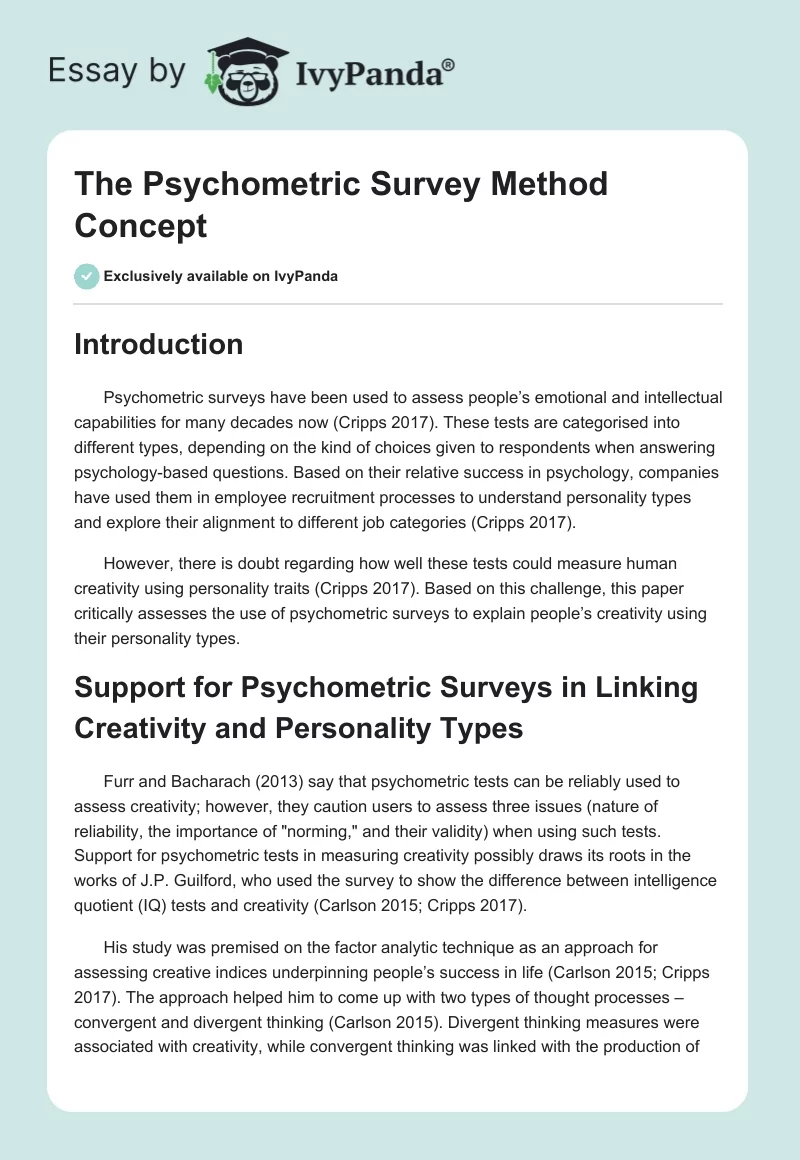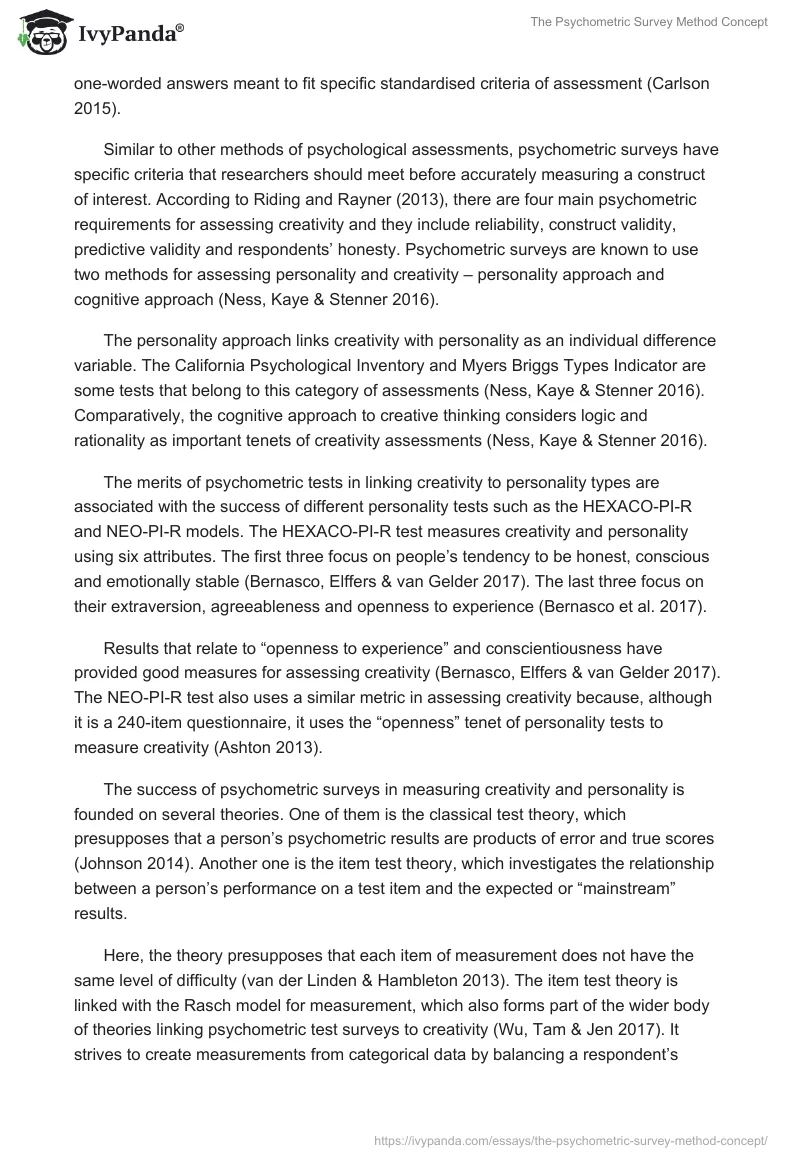Introduction
Psychometric surveys have been used to assess people’s emotional and intellectual capabilities for many decades now (Cripps 2017). These tests are categorised into different types, depending on the kind of choices given to respondents when answering psychology-based questions. Based on their relative success in psychology, companies have used them in employee recruitment processes to understand personality types and explore their alignment to different job categories (Cripps 2017).
However, there is doubt regarding how well these tests could measure human creativity using personality traits (Cripps 2017). Based on this challenge, this paper critically assesses the use of psychometric surveys to explain people’s creativity using their personality types.
Support for Psychometric Surveys in Linking Creativity and Personality Types
Furr and Bacharach (2013) say that psychometric tests can be reliably used to assess creativity; however, they caution users to assess three issues (nature of reliability, the importance of “norming,” and their validity) when using such tests. Support for psychometric tests in measuring creativity possibly draws its roots in the works of J.P. Guilford, who used the survey to show the difference between intelligence quotient (IQ) tests and creativity (Carlson 2015; Cripps 2017).
His study was premised on the factor analytic technique as an approach for assessing creative indices underpinning people’s success in life (Carlson 2015; Cripps 2017). The approach helped him to come up with two types of thought processes – convergent and divergent thinking (Carlson 2015). Divergent thinking measures were associated with creativity, while convergent thinking was linked with the production of one-worded answers meant to fit specific standardised criteria of assessment (Carlson 2015).
Similar to other methods of psychological assessments, psychometric surveys have specific criteria that researchers should meet before accurately measuring a construct of interest. According to Riding and Rayner (2013), there are four main psychometric requirements for assessing creativity and they include reliability, construct validity, predictive validity and respondents’ honesty. Psychometric surveys are known to use two methods for assessing personality and creativity – personality approach and cognitive approach (Ness, Kaye & Stenner 2016).
The personality approach links creativity with personality as an individual difference variable. The California Psychological Inventory and Myers Briggs Types Indicator are some tests that belong to this category of assessments (Ness, Kaye & Stenner 2016). Comparatively, the cognitive approach to creative thinking considers logic and rationality as important tenets of creativity assessments (Ness, Kaye & Stenner 2016).
The merits of psychometric tests in linking creativity to personality types are associated with the success of different personality tests such as the HEXACO-PI-R and NEO-PI-R models. The HEXACO-PI-R test measures creativity and personality using six attributes. The first three focus on people’s tendency to be honest, conscious and emotionally stable (Bernasco, Elffers & van Gelder 2017). The last three focus on their extraversion, agreeableness and openness to experience (Bernasco et al. 2017).
Results that relate to “openness to experience” and conscientiousness have provided good measures for assessing creativity (Bernasco, Elffers & van Gelder 2017). The NEO-PI-R test also uses a similar metric in assessing creativity because, although it is a 240-item questionnaire, it uses the “openness” tenet of personality tests to measure creativity (Ashton 2013).
The success of psychometric surveys in measuring creativity and personality is founded on several theories. One of them is the classical test theory, which presupposes that a person’s psychometric results are products of error and true scores (Johnson 2014). Another one is the item test theory, which investigates the relationship between a person’s performance on a test item and the expected or “mainstream” results.
Here, the theory presupposes that each item of measurement does not have the same level of difficulty (van der Linden & Hambleton 2013). The item test theory is linked with the Rasch model for measurement, which also forms part of the wider body of theories linking psychometric test surveys to creativity (Wu, Tam & Jen 2017). It strives to create measurements from categorical data by balancing a respondent’s creativity and personality traits with the difficulty of the item being measured (Ness, Kaye & Stenner 2016).
Collectively, these theories support the success of psychometric surveys in understanding creativity through personality types because they endear to improve its reliability and validity. Additionally, Price (2016), McCoach, Gable and Madura (2013) say that psychometric tests score high above the reliability index of 0.7 on the Cronbach alpha scale, meaning that they are “highly reliable” tests for measuring creativity and personality.
Weaknesses of Psychometric Surveys in Linking Creativity with Personality Types
Critics of psychometric testing draw attention to social desirability as one of its key weaknesses in linking creativity and personality (Ness, Kaye & Stenner 2016). This flaw is commonly observed among studies, which have participants who feel that the tests “judge” them (Ness, Kaye & Stenner 2016). Consequently, they may feel the need to respond in a manner that disapproves this notion, as opposed to being truthful about their responses.
This weakness could manifest in two ways – self-deception and impression management. In self-deception, participants tend to underrate their weaknesses and magnify their strengths (Ness, Kaye & Stenner 2016). Comparatively, in impression management, they may “act nicely” to minimise the probability of social disapproval (Ness, Kaye & Stenner 2016).
Psychometric tests have also been linked to weaknesses relating to the presence of extraneous variables, such as weather and mood of the participants, in research studies (Ness, Kaye & Stenner 2016). For example, informants could provide inaccurate findings when the surveys are administered in hot temperatures because of low attention levels, vigilance and reaction times. This way, it is difficult to find a reliable measure for personality types or creativity Gulliksen (2013) also suggests that cultural bias could affect how questions are formulated in psychometric surveys, thereby undermining the probability of using personality types to assess creativity levels.
Lastly, psychometric surveys have also been criticised for their inability to measure multilingual creative advantages that may appear as personality traits (Fulcher & Davidson 2013). Therefore, alternative tests such as the Lifetime Creativity Scale and the Creative Personality Scale have been mentioned as replacements for measuring these attributes (Fulcher & Davidson 2013).
Analysis
The weaknesses of psychometric surveys in improving people’s understanding of creativity through personality types centre on the probability that respondents could provide fake results (Ness, Kaye & Stenner 2016). However, the normal distribution of test scores could mitigate this problem. Indeed, most psychometric tests have an inbuilt mechanism for measuring how a person’s creativity and personality scores compare to the norm (Kolen & Brennan 2014). Therefore, researchers can still assess personalities and creativity objectively and within a contextualised but in-depth manner.
Proper questionnaire designs could also address this weakness because they shape respondents’ views (Ness, Kaye & Stenner 2016). In light of this discussion, Kline (2013) suggests that the questions posed in psychometric tests should be pre-tested under typical conditions to evaluate how best they measure creativity using personality traits. Additionally, Loewenthal and Lewis (2015) caution that the findings of psychometric tests, especially when measuring creativity and personality should be contextualised within a specified set of data because creativity is not a standardised variable.
For example, it is difficult to analyse creativity in isolation because it needs to be categorised or normalised across a larger group of test scores to provide a reliable comparison (Ness, Kaye & Stenner 2016). Psychometric surveys normalise data across a large representative sample of responses, thereby providing a reliable sample of creativity (Ness, Kaye & Stenner 2016). For example, people who score 90% on the extroversion scale should understand the score to mean that they are 90% more extroverted than the group of respondents where the normal distribution occurred.
Based on the above views, questions asked in psychometric surveys help us to understand creativity as a normalised variable (Urbina 2014). Here, it is important to develop personality-identifying questions within the constructs they are supposed to measure. For example, if creativity is assessed without considering the role of time, which often influences associated processes, an erroneous result may be obtained. Ness, Kaye and Stenner (2016) also highlight the importance of factoring in the response style of the target population in answering research questions and interpreting test scores.
Conclusion
According to the findings highlighted in this paper, psychometric tests are some of the most popular assessment techniques for measuring personality types and creativity. Consequently, they have a record of success in this regard. Broadly, the success of the psychometric survey in measuring these two human attributes stems from its objectivity. In other words, the test has helped researchers to measure creativity in almost a similar manner as techniques adopted in the natural sciences. Its inherent weaknesses are premised on its vulnerability to social desirability weaknesses and the effects of extraneous variables on test scores.
However, these weaknesses are not unique to the technique because other personality assessment techniques have the same challenge. Nonetheless, the evidences gathered in this study show that these tests improve people’s understanding of creativity as a normalised variable. Stated differently, its helps in portraying creativity as a subjective human trait that can be explained using personality types.
Reference List
Ashton, MC 2013, Individual differences and personality, 2nd edn, Academic Press, London.
Bernasco, W, Elffers, E & van Gelder, J 2017, The Oxford handbook of offender decision-making, Oxford University Press, Oxford.
Carlson, AL (ed.) 2015, Genius on television: essays on small screen depictions of big minds, McFarland, London.
Cripps, B (ed.) 2017, Psychometric testing: critical perspectives, John Wiley & Sons, London.
Fulcher, G & Davidson, F 2013, The Routledge handbook of language testing, Routledge, London.
Furr, RM & Bacharach, VR 2013, Psychometrics: an introduction, 2nd edn, SAGE, London.
Gulliksen, H 2013, Theory of mental tests, Routledge, London.
Johnson, TP (ed.) 2014, Handbook of health survey methods, John Wiley & Sons, London.
Kline, P 2013, Handbook of psychological testing, 2nd edn, Routledge, London.
Kolen, MJ & Brennan, RL 2014, Test equating, scaling and linking: methods and practices, 3rd edn, Springer Science & Business Media, London.
Loewenthal, K & Lewis, CA 2015, An Introduction to psychological tests and scales, 2nd edn, Psychology Press, London.
McCoach, DB, Gable, RK & Madura, JP 2013, Instrument development in the affective domain: school and corporate applications, 3rd edn, Springer Science & Business Media, London.
Ness, H, Kaye, H & Stenner, P (eds) 2016, DE300- investigating psychology 3, 1st edn, The Open University, Milton Keynes.
Price, LR 2016, Psychometric methods: theory into practice, Guilford Publications, London.
Riding, R & Rayner, S 2013, Cognitive styles and learning strategies: understanding style differences in learning and behaviour, 3rd edn, Routledge, London.
Urbina, S 2014, Essentials of psychological testing, John Wiley & Sons, London.
van der Linden, WJ & Hambleton, RK 2013, Handbook of modern item response theory, 3rd edn, Springer Science & Business Media, London.
Wu, M, Tam, HP & Jen, T 2017, Educational measurement for applied researchers: theory into practice, Springer, London.


